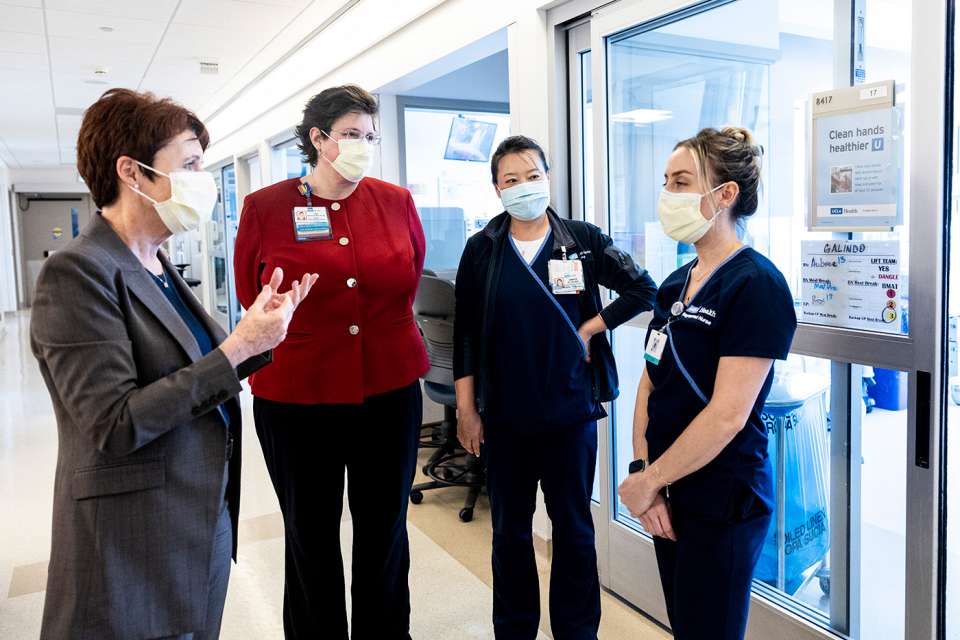A Year in Review

By Karen A. Grimley
PhD, MBA, RN, NEA-BC, FACHE, FAAN
Chief Nursing Executive, UCLA Health
Assistant Dean, UCLA School of Nursing
Spring is a time of rebirth, and today, as I reflect back on 2022, I see a glimmer of hope. Pandemic restrictions are lifting and people are starting to gather together with intention and gratitude. Celebration and camaraderie are more noticeable, and compassion fatigue, exhaustion and feelings of despair seem to be subsiding. We truly are social beings, and this coming together is more meaningful than ever. We can see the importance of people in our lives. We can feel renewed energy, and we see hints of joy, which gives me hope for a future full of promise for UCLA and UCLA Health nursing.
Despite the challenges we have faced, we have stayed focused on the health and safety of our patients and those who care for them. Things we’ve done this past year have been aimed at getting ready for the day we don’t have to use pandemic-related constraints and ensuring that we are responding with intention to what we have experienced this past year. The sheer number of people requiring care, and ensuring our ability to deliver care to our standard, contributed to compassion fatigue and an atmosphere of sadness for many nurses. People seemed to be more terse and demonstrated more frustration this past year, whether they were getting care or giving care. It made for hard feelings, challenges and threats to safety, and it was also a call to action.
In response, we embarked on a systemwide undertaking called A Safer U, a current-state analysis of all the initiatives, activities and programs in place that address some facet of safety for staff, patients and their families. I’m very proud to say that this nurse-led interdisciplinary team has come together to create a focused and comprehensive approach to improving the safety of our environment and the safety and well-being of the people in it. Efforts around prevention, education and remediation of workplace violence are being addressed. We’ve started to see wonderful results with projects like the weapons-detection systems in our emergency department entrances, wearable staff safety buttons, and other staff safety alerts and education.
This past year, we increased the availability of our care delivery model in-service called Relationship-Based Caring. This three-day refresher program is designed to review elements of relationship-based care with nurses. What we have learned from this work, called Reigniting the Spirit of Caring, is that nurses found it to be not only a refresher course but a sort of intentional self-care retreat, which has bolstered morale and engagement with their peers and with their patients.
At the relationship-based care meetings we’ve been hosting, many of our nurses, on their first day, described feelings of compassion fatigue, dread and sadness. They began to question why they went into nursing. Health care has been slow to realize the true devastation of COVID-19, and our question becomes, “How do we address the fatigue and disillusionment of those who stayed in a fragmented system?” Over the past year, we’ve spent time trying to help our nurses describe their current circumstances and describe what their future needs to look like.
To address some of these issues, we’ve invested in a comprehensive workforce strategy that has ensured we have the right number of staff to care for patients consistently. We’ve streamlined the onboarding process, created agreed-upon staffing measures, and designed metrics and a rewards and recognition program to ensure we were cognizant of what was happening. The results of this past year’s effort can be seen in our nursing engagement and excellence scores, which exceeded the national benchmarks in at least six of seven categories across our system. Our nursing professional governance model is alive and well, with lots of innovative and creative activities continuing. And we strengthened our partnership with the UCLA School of Nursing.
Today we should survey our nursing landscape and celebrate all that we have seen and done this past year. We have achieved much. We not only surpassed national benchmarks, but we also partnered together for one another. And we did it because it is who we are and how we used our resources and relationships to reinvigorate our teamwork and camaraderie, which can be seen in A Safer U, improved nursing workforce strategies, new application of relationship-based care, and stronger nursing and health care worker support. With strong staffing as a foundation, we can turn our attention to the future; our focus remains on our patients, the nursing teams that care for them and the health of our care environment.
A heartfelt thank you to all of those nurses and staff who traveled on this journey. Your compassion and your commitment to our patients and to each other, no matter what the challenges, never cease to inspire me. Together we’ve come through stronger and more engaged as a team – ready for what lies ahead. Thank you for all you do.
